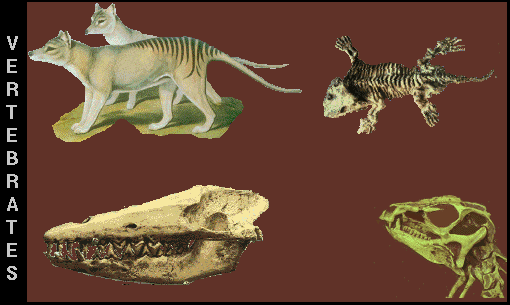Introduction to the Vertebrates


Although not the most numerous group of animals in either number of individuals or in number of taxa, the vertebrates are an endlessly fascinating group of animals. Vertebrates are interesting partly because we are intimately familiar with them, but also because we ARE them. Our species, Homo sapiens, is included within the Vertebrata.
Vertebrates are also interesting because they are easy to find. Many other groups of organisms cannot be seen with the naked eye or reside in places inhospitable to humans, like the sea floor. We coexist with many other vertebrates and are often quite aware of them in our environment. We also have many biological, social, cultural and historical ties with vertebrates. We have domesticated dogs, cats, and birds, and have used horses as a means of transporation. We have used carrier pigeons as a means of communicating over long distances. We also use many products from bovids, like milk and leather. In some religions, cows are sacred, objects of reverence.
Vertebrates have a long history on this earth -- more than 500 million years, from the late Cambrian up to today. These first vertebrates lacked jaws, like the living hagfish and lampreys. Jawed vertebrates appeared 100 million years later, in the Silurian.
The vertebrates show affinities with other chordates but share some characters that make them unique. Some have argued that many of the characters that describe vertebrates have been derived from the same set of cells, the neural crest cells. These cells appear early in development, and only vertebrates have them. From neural crest cells are derived the skull and jaw bones.
While vertebrates have a long and interesting fossil record, humans are unfortunately helping to add to the list of organisms that no longer exist. These extinctions reduce the diversity of life on the planet and destroy our ability to understand all aspects of biology. We hope to show you the diversity of vertebrates that has existed in the past and the diversity that exists today. We also hope to show how, taken together, vertebrates extinct and extant can help us understand a great deal about the forces that have shaped the evolution of our world and ourselves in the past and help us predict and understand the future.
You can navigate deeper into the Vertebrate groups by selecting Systematics!
UCMP Special Exhibit: Vertebrate FlightVisit our series of pages on the wonder of flight in vertebrates. How do they do it? How and why did flight evolve? What do a pterosaur, a bat, and a bird have in common? Find out for yourself! |


